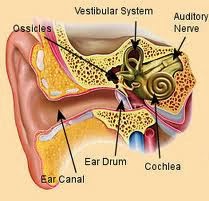 |
| Pulsating Tinnitus |
It is firmly recommended that those who suffer from pulsatile tinnitus should find an expert physician that is given to circulatory system studies, and have these specialists perform a thorough evaluation on them.
Several studies and researches have shown that the underlying cause for identifying a pulsatile ear ringing is physiologic in nature. Having said that, there are wide range of causes of this condition that cannot be diagnosed, and their causative agents unidentifiable.
More Facts about Pulsating Tinnitus
In most cases, pulsatile tinnitus is categorized as objective type of tinnitus; in essence, it is possible for others to hear the disturbing sound that the patient is hearing, but with the aid of a stethoscope or other high tech gadgets. The examiner of the patient in particular can also experience the condition on auscultation of the auditory canal or the structures surrounding it, using an auscultation tube.
Other conditions that can be associated with pulsating tinnitus include Arterioevenous shunts, Vascular Abnormalities, Glomus tumors of the jugular, Vascular loop (of the internal auditory canal), Hypertension (high blood pressure), Dehiscent jugular bulb, Palatomyoclonus (small spasms of muscles in the soft palate area), mechanical abnormalities and others.
Pulsatile tinnitus may be heard as many featured sounds such as rough blowing sound which falls in time with respiration, clicking increased pitch that produces rhythmic feeling and a reduced pitch thumping. There may also be lone rhythmic beats, swooshing sound, or different biphasic beats.
Preventing Tinnitus
Whether pulsatile or other forms of tinnitus, the condition could eventually become a permanent one; for this reason, it is very essential for people to take preventive measures. A situation where a ringing in the ears is loud as a result of prolonged exposure to sources that produce loud sound or noise (e.g. industrial workplace or music); it is possible that permanent damage has already taken place. Staying exposed to sound levels of 70 dB for a long period of time can impair hearing. Therefore, if you are a DJ or a musician, it is recommended that you use special earplugs provided for such purpose. This gadget will substantially assist in the prevention of tinnitus. You will still enjoy your music or DJ work while using the special earplugs.
For those who use loud electrical equipments like vacuum cleaners; it will also help to use earplugs. The individuals who frequently operate machines like hammer drills, lawn mowers and grinders can use earmuffs to offer protection to their ears. This will significantly help in preventing tinnitus from developing in the future, and prevent the effect from worsening in the present. Also try and check out for potential ototoxicity medications. However, it is possible for ototoxiclity to be cumulative between medications. If you must use ototoxic medications, you must follow the prescription details as given by the physician e.g. dose and dosage interval.
Generally, for existing tinnitus, you can choose other alternative treatments such as herbal medicine and other natural remedies. However, you have to make careful research and obtain reliable facts about your intended herb use for your tinnitus problem.






















